In that space, workers compared collective bargaining agreements, assessing, for example, disparities between the maternity rights in different companies. This laid the basis for collective and solidarity actions. SACCAWU pointed to an interesting example where the mall committee entered into negotiations with the mall management on behalf of all workers with regard to a childcare plan for workers involved in late trading.
The mall committee conducted a survey with a particular focus on casual workers. The survey enquired about the number of children that needed childcare and what workers could afford to pay for childcare. A compromise was reached. Management offered a venue, meals for the children during the shift that the worker is on duty and entertainment such as art. Workers were responsible for finding and funding a suitable childcare worker.
The mall committee also offered women working in different companies the space to share their experiences of common problems like the impact of late trading on personal safety and family lives.
The very localised and yet diverse settings of the malls – with many companies, small shops and restaurants – can play an important role in appreciating both the different and similar challenges facing, for example, a young woman employed as a part-time waitress in a Wimpy restaurant and permanently-employed woman in Pick n Pay supermarkets.
Both women are involved in late trading, feel the insecurity of travelling by unreliable public transport to and from work, are constantly concerned about childcare arrangements, have irregular lunchtimes and are involved in shift work.
But the young woman at Wimpy is constantly being intimidated by her manager with the threat that they can easily be replaced. She knows that if she falls pregnant she will probably not get her part-time job back, she believes she has no labour rights as a part-time worker and she has had no exposure to a union.
Imagine that the Pick n Pay and Wimpy shops are next to each other at the mall and the two women often see each other and travel in the same public transport. Having the mall committee gives two women from different companies an opportunity to really appreciate each other’s frustrations and challenges, which is an important first step in building consciousness and solidarity.
Creating such a space is not without its challenges, and SACCAWU can attest to that. Irregular lunchtimes and shift work made meeting times a real challenge. This means flexible processes became useful in some malls, for example, using different meeting times to accommodate the different lunch times.
Mall committees are also important places for experimenting with organising young women. Straight from school, working as part-timers with little organisational experience, the young women feel both vulnerable but also excited at the possibility of being involved and learning new things.
In the malls, members of the SACCAWU Gender Structures have creatively inducted young women workers into the union through both formal as well as informal methods.
Young women were encouraged to participate in the initial negotiations with mall management around accessing physical space to hold mall committee meetings. These initial negotiations were important for young women to get a sense of the attitude of the mall and property manager. Also, the women began to feel comfortable seeing the mall as their workplace.
Formal induction processes were a combination of union reports and educational activities that could include issues like workplace related sexual harassment, collective bargaining issues like parental rights and broader societal issues like customary marriage and domestic violence.
Careful attention was placed on the educational methodologies used in both union report backs as well as educational meetings.
For many young women, that was their first experience of women-led activities and the gender activists paid careful attention to role modelling and mentoring.
One of the older gender activists that assisted with the development of the Vaal Mall Committee identified “having an internal vision of your own development as an activist” as important in being a role model and in mentoring young women. She felt this helped to make conscious what assisted and what acted as a block in your own development, which when showed through action and not through “preaching” to the young women can be very effective in the mentoring process.
All the gender activists spoke about “empathy” as being essential to their gender work. That sense of empathy played an important role in their work with young women.







